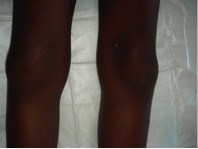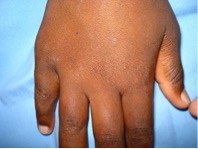Joint Swelling and Lymphadenopathy
Adam is a 12 year old boy referred from a local community clinic in South Africa with complaints of swollen ankles and knees for approximately 3 years. He was diagnosed with Human Immunodeficiency Virus (HIV) infection 6 months ago. His mother had died of HIV related complications when he was 2 years old and he is cared for by his older sister who noted that he had swollen and restricted ankles and knees. His adherence to antiviral therapy has been very poor. He is well grown, not acutely unwell.
On examination he is found to have generalised lymphadenopathy and is apyrexial.
A pGALS examination reveals many abnormalities including restriction of wrists, fingers, knee and ankles, swelling of his knees and thigh muscle atrophy. On detailed musculoskeletal examination he is found to have 18 swollen and/or limited and tender large and small joints in an asymmetrical distribution. His cardiovascular and respiratory examination is normal.
Investigations, aimed at excluding other causes for arthritis are done. These reveal a normal Full [Complete] Blood Count but elevated ESR 63mm/hr. ANA and Anti-dsDNA are negative. HLA-B27 and RF are also negative; ASOT and Anti-DNAse B are not increased. Hepatitis B and Tuberculosis screening are both negative.
This is Chronic HIV related Arthritis
Chronic HIV related Arthritis most frequently presents in older children who have acquired HIV infection at birth but who have not been treated with Antiretroviral therapy. Typically children present after many months or years of relatively painless joint swelling and limitation. The pattern of joint involvement is frequently polyarticular, involving small and large joints asymmetrically. Enthesitis and psoriatic manifestations are not uncommon. The presence of monoarthritis should always raise the suspicion of infection as children with HIV are more susceptible to Tuberculosis and bacterial (septic) arthritis. HIV arthritis can usually be differentiated clinically from Acute Rheumatic Fever by the absence of migratory polyarthritis and the absence of cardiac involvement.
Antiretroviral therapy is the mainstay of treatment, although intra-articular corticosteroids and Non-Steroidal Anti-inflammatory drugs can be useful in the early phases of therapy to hasten symptomatic improvement. DMARDS are occasionally required to manage arthritis that does not resolve despite adequate antiviral therapy.
More information about HIV and musculoskeletal presentations is available in the Clinical Assessment, Limping Child and Arthritis modules.
The photograph below shows swelling of both knees (more on the right) and thigh muscle wasting

The photograph below shows swelling of the small joints of the fingers


